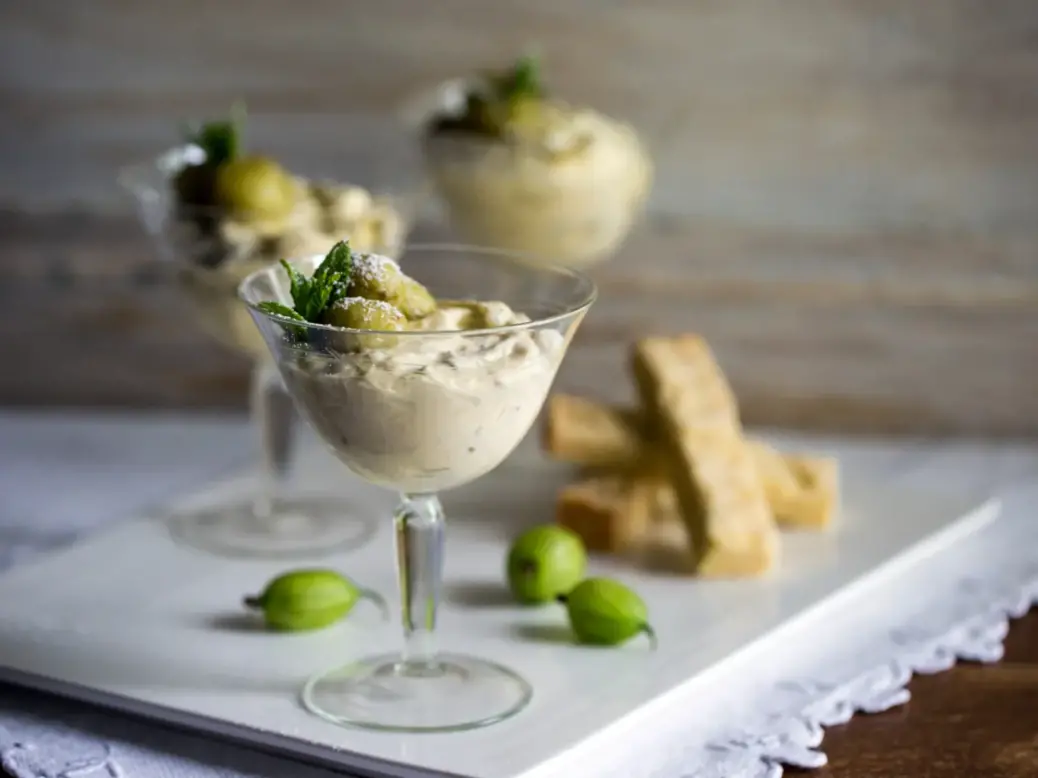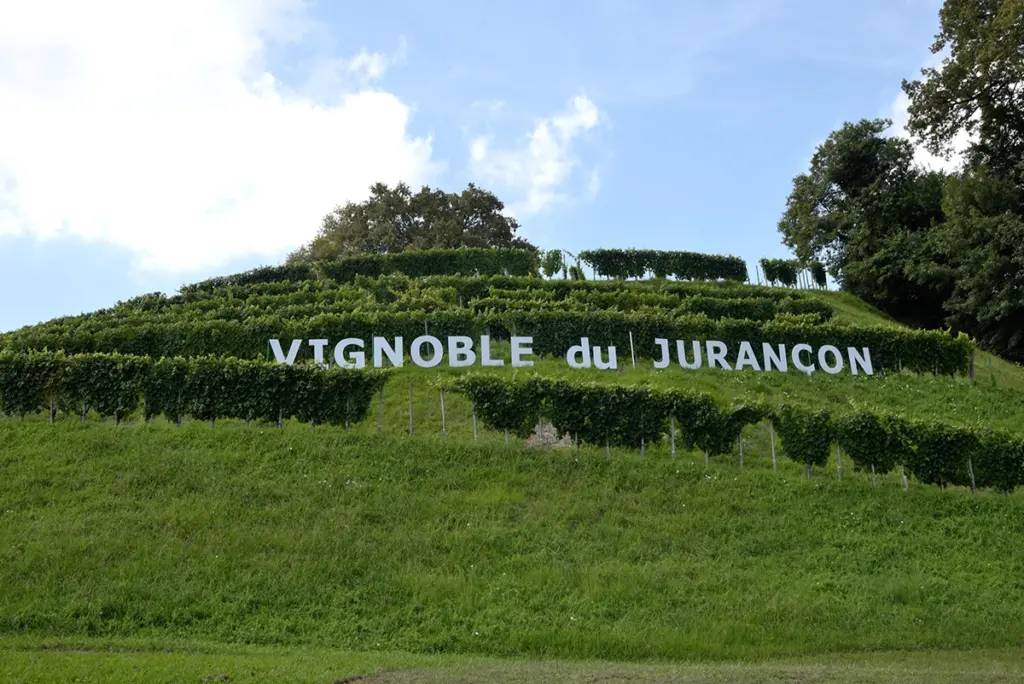
The World of Fine Wine has teamed up with Great British Chefs to find the best wine matches for a range of classic dishes. We start here with a much-loved British dessert, gooseberry fool, paired with wines selected from the WFW tastings archive by leading food and wine writer and WFW columnist, Joanna Simon.
After a thorough review of the Great British Chefs’ recipe, Joanna Simon came up with two suggestions for making the most of gooseberry fool: A Jurançon Moelleux, such as the 2018 Charles Hours Uroulat Jurançon from our Jurançon and Pacherenc tasting featured in WFW80, or a youthful Barsac, like the 2017 Château Doisy-Daëne Deuxième Cru, which was highlighted in our Bordeaux 2017 tasting in WFW74.
Below, you’ll find a brief introduction to the recipe by Louise Robinson, as well as comprehensive tasting notes and introductions to the featured tastings.
Gooseberry Fool
Louise Robinson for Great British Chefs
A dessert consisting mostly of fresh cream and fruit can barely be called a recipe, and yet gooseberry fool is a classic dish that can be traced back to Elizabethan times. With British gooseberries now in season, it is the perfect time to serve this summery pudding. After all, what could be more enjoyable than clouds of cream swirled with bright green berries, served with a shortbread biscuit or two…
…There is much advice on how to make the best shortbread. Some advocate just flour, butter and sugar, gently bought together, will make the most tender crumbly biscuits. Others say that shortbread should have a slight crunch. I prefer my shortbread to have some texture, especially when served with such a creamy dessert, so I have added ground rice but you could also use polenta…

For more information and the full recipe, visit Great British Chefs
Jurançon and Pacherenc: Countryside Force
In WFW80, Andrew Jefford was joined by Stephen Brook and Stephan Reinhardt for a tasting of 29 of the best examples of these southern French appellations’ finest sweet wines.
The fine wines of the South of France are a gift, in large part, of its slopes, altitude, and elevation. Southern France has little lowland. Of the three zones that could be so described, the Camargue’s agricultural scene is dominated by rice and livestock raising; market gardening busies the Perpignan plain; while Languedoc’s own coastal plain is home to its less ambitious wines. Provence’s airy petal-pink delicacy, by contrast, is a sub-Alpine legacy; Languedoc’s best wines lodge in the foothills of the Cévennes, the Montagne Noire, and the Corbières; even Châteauneuf-du-Pape sits on a raised plateau, while the Southern Rhône’s villages and crus creep up the slopes to each side of a steadily broadening valley. And the vineyards of the Pyrenees? One, Roussillon, is a southerly Mediterranean vineyard of sea terraces and climbing valleys. The other lies to the north of the mountains, simultaneously open to—yet sheltered from—the Atlantic, in Béarn and Gascogny, with a footnote in Basque Country (Irouléguy). These vineyards are, for the time being at least, most comfortable and successful between 300ft and 1,300ft (100m and 400m), though climate change may lift the possibilities for viable viticulture above 1,600ft (500m).

Great and growing Jurançon (from Béarn) and Pacherenc (from Gascony) are the two great white wines of the Atlantic side of the Pyrenees. Jurançon occupies a cooler, more evidently mountainous site than Pacherenc; you can taste as much in its acid profile, which cuts and slices. There are red wines from Béarn but they struggle to make a mark; few of these reds yet challenge white Jurançon for personality, intensity, or longevity. Warmer Pacherenc, by contrast, occupies exactly the same appellation boundaries as Madiran, Gascony’s greatest red wine and one of Southern France’s finest, though most secretive. White grape varieties defer to red in the hotter spots here, and the acid balance of the whites makes for a gentler, mellower balance than in Jurançon. Passerillage (raisining) is far more common than botrytis in driving the acquisition of sweetness for Jurançon and Pacherenc alike. Both appellations have expanded over recent years. Jurançon plantings reached 3,266 acres (1,355ha) in 2019, while the combined plantings of Madiran and Pacherenc have now attained 4,200 acres (1,700ha)—though only 741 acres (300ha) of those are planted with white varieties, making Jurançon clearly the more significant white wine. Gros Manseng and Petit Manseng are the principal grape varieties common to both these AOPs. They dominate Jurançon (especially Petit Manseng) and Jurançon Sec (especially Gros Manseng), seasoned by Courbu, Camaralet de Lasseube, and Lauzet. For Pacherenc, Arrufiac, and Petit Courbu (a different variety to Courbu) are used alongside the two Mansengs—and used more widely than are the complementary varieties in Jurançon. (The Château Montus Sec is 80 percent Petit Courbu, accounting for its “distinctively different” style.) Jurançon, in particular, is an opportunistic vineyard: a patchwork of protected, niched sites which often face south toward the mountains, and are sited on top of the rumpled pillow of clay-rich depositional materials (conglomerates and flysch) found between the Gave de Pau and the Gave d’Oléron (a gave is a small though high-velocity Pyrenean river)…
The wine chosen from this tasting was:
Charles Hours Uroulat Jurançon 2018 (13% ABV) | 93.3
Stephen Brook | The nose of this wine is quite exotic, with hints of tropical fruit, such as pineapple, as well as stone fruits. Very sweet and succulent, this is saved from being cloying by its underlying acidity, which gives persistence and precision. There is no rawness here and it’s already approachable but should age well. Dramatic and long. | 94
Andrew Jefford | Mid- to deep gold. Sweet and attractive on the nose, with drier as well as more crystalized elements to the aroma: lots of dried, crystalized apple slices (though not the tarte tatin of some of the other wines); fresh acacia honey; broom flowers and almond blossom. Gracious and beguiling aromas. Dense, full, concentrated, and exciting. As always with the best Jurançons, you look at the acidity first, to see what kind of detonating power it has, and how much sugar action it will send raining down in its wake after the detonation has happened. And there is plenty here: honey, malt, mushroom, herbs, dried flowers. An exciting wine, with plenty of aromatic force secreted away in its pores. | 93
Stephan Reinhardt | Intense in its golden-yellow color, this 2018 Jurançon displays a very clear bouquet, with white nougat, white chocolate, apricot, and ripe-fruit aromas on the nose, but is very elegant, refined, and rich on the palate, leading to a clear, sweet, but also savory and saline finish. | 93
2017: A frostbitten but potentially rather wonderful year
In WFW74, Michael Schuster led one of our “Déjà-Bu” tastings, in which he was joined by Andrew Jefford and Simon Field MW to re-taste a recent Bordeaux vintage, comparing its in-bottle performance to the original en primeur assessment.
A frostbitten but potentially “rather wonderful year”, this was my title for the en primeur review of 2017 Bordeaux, inspired by a comment by Christian Seely, when I was tasting at Pichon Baron: “If you were not hit by frost, this is actually a rather wonderful year.” As we know, four years is a good moment to reassess the wines, after two years in bottle, to see how they measure up to impressions in barrel…
… Sauternes’s grapes were broadly harvested in two large tries, the first over the final eight to ten days of September, the second over the first two weeks of October, in mostly ideal conditions…
… Conditions for fine noble rot did eventually develop toward the end of September and in early October, but you had to wait, and all the while the grapes were becoming richer in sugar and lower in acidity. And it would seem that, in many instances, there simply wasn’t time enough for a sufficient concentration of high quality noble rot to develop, over a number of tries, before the acidity dropped uncomfortably and pressed one to pick. So, the results are uneven. There are plenty of good wines but few that are exceptional. As a group, they are a long way from the quality and class of 2015 and 2014, for example.
The wine chosen from this tasting was:
Château Doisy-Daëne Deuxième Cru 2017 | 93
Simon Field MW | Subtle limonite color, then a nose that is dominated by dried fruit, straw even, its exotic tenor tempered by a smoky subtext. The palate is potent, long, and resourceful, notes of guava, barely sugar, and almond held in check by a somewhat recalcitrant structure that will, in the fullness of time, flatter us through its generous core. | 90
Andrew Jefford | Bright, full gold in color. All of the classic lemony freshness of Barsac to smell: a tarte au citron, just pulled from the oven. Honeyed and creamy, too: fine aromatic intricacy here. Something gingery as well, and a planty, sappy presence: pure, refined, commanding. A truly super Barsac nose. Wow: Rich for Barsac! Super-rich: huge concentration, depth, and drive, and a lovely saturating salty glutting quality on the tongue, even though Barsac never carries the sumo-like weight of the biggest Sauternes. There is (as on the aroma) a planty or sappy presence in addition to the candied fruits on the palate, which is very gratifying. Lots of lemon freshness, and by the way the lemon is perfumed as well as flavory; lemon verbena, too, and even lemon grass isn’t out of the question. And gorgeous crystallized ginger, too. Very aromatically complex on the palate, in other words. An utterly commanding and hugely impressive Barsac 2017 of character, perfume, and singularity. | 95

